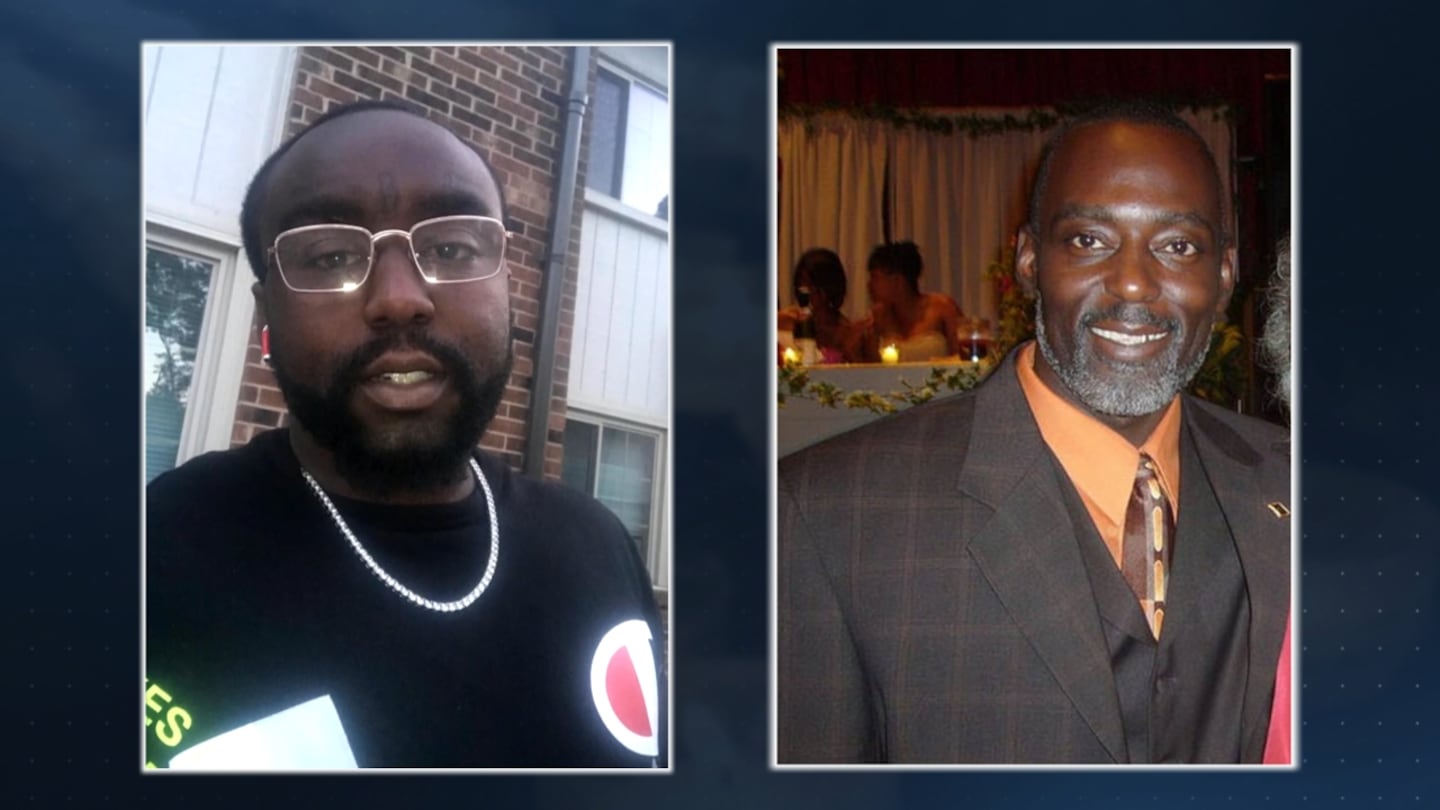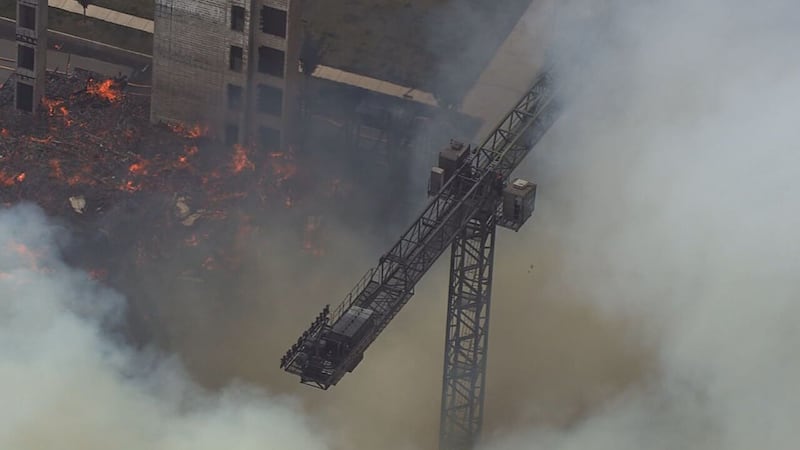CHARLOTTE — When it comes to fire, seconds make a world of difference. Nothing proves this more than the 2023 SouthPark fire.
Charlotte Fire Department Chief Reginald Johnson sat down with Channel 9 Reporter Joe Bruno after Bruno obtained CFD’s After Action Report on the five-alarm SouthPark fire. The findings were presented to Charlotte City Council on Monday.
READ PREVIOUS:
- SouthPark fire: ‘Not a day has gone by that I haven’t thought about it,’ firefighters say
- Families of SouthPark construction fire victims file wrongful death lawsuit
- Construction companies cited for OSHA violations after deadly SouthPark fire
The fire
May 18, 2023 was one of the darkest days in Charlotte’s history. The five-alarm fire at the Modera SouthPark site killed two workers, Demonte Sherrill and Reuben Holmes.
A lengthy independent report ordered by Chief Johnson and obtained by Channel 9 outlines what happened, and as a result, what needs to change.
“This obviously was a very significant fire in Charlotte and a very complex low frequency, high risk event,” Chief Johnson said. “There’s a lot of good stuff that went on and there’s a few things that we can get better.”
The report notes the complex, which was largely under construction, was practically a vertical lumber yard. The first two floors were for parking. The remaining five stories were all uncompartmentalized wood framing. There were no sheetrock or barriers to prevent fire growth.
On the ramp between the parking garage and the second floor was a mobile trailer housing a generator and supplies for spray foam insulation. The report says a diesel engine inside that trailer suffered a catastrophic failure, resulting in combustible fluids contacting the hot surfaces of the engine. Vapors ignited and a small fire quickly spread to the nearby wood framing.
The fire is officially classified as accidental.
The fire was discovered by workers at 8:55 a.m. The report says they tried to put it out with portable fire extinguishers but failed. It wasn’t until 9:02 a.m., seven minutes later, that they called 911. At 9:07 a.m., Charlotte Fire arrived. That was 12 minutes after workers first discovered the fire.
“If the 911 call was made right when the fire was discovered, could this have unfolded differently?” Bruno asked.
“I believe so,” Chief Johnson said. “This fire was able to grow exponentially before firefighters even arrived on scene. And so we stress all the time to call 911 immediately when a fire is discovered, just so that we can get there and probably catch it before it gets out of hand.”
“If that call was made at 8:55, and you arrived by 9, what exactly do you think could have changed in this situation?” Bruno asked.
“At that point in time, we probably could have stretched our normal hose lines, been able to coordinate water supply and get in there. Because the fire would not have extended into the structure at that point in time, it started in the trailer,” he said. “There’s a good chance we could have probably mitigated it a little bit earlier.”
“If that call was made right away, do you think Mr. Holmes and Mr. Sherrill would be alive?” Bruno asked.
“That I can’t guarantee,” he said. “Even though we’re saying it’s hypothetical, if we had gotten there at 9 instead of 9:07, there’s a chance that we could have prevented that. But I can’t say that ultimately, because we still don’t know how much fire spread had occurred in that time period.”
The response
The delays in battling the fire continued even after Charlotte Fire arrived. The report says Engine 14 established a water supply on Barclay Downs and hooked into the Fire Department Connection. They were told it was operational. It wasn’t.
Engine 12 also ran into issues when they took their hose bundles into the lower deck and stretched them to the standpipe, which also was not working.
“Having that misinformation did delay us even more in suppression efforts initially, when we first got on the scene,” Chief Johnson said.
“Does that come down to the developer not being prepared for this situation? Or was it just the building was so in its infancy stages of being constructed, that at that point it wasn’t ready?” Bruno asked.
“I believe that there were some definite issues in reporting and time and construction of this building without necessarily our fire prevention inspectors being engaged early. And that possibly could have been prevented if we had been notified earlier of this type of construction, vertical construction, at that point in time. We could have noticed that, ‘Hey, there’s one stairwell, the standpipe is not functional.’ These type of things would have been handled by our inspectors,” he said.
The report goes into great detail about how firefighters attempted to rescue Holmes and Sherrill.
As the fire raged, Charlotte Fire Capt. Mike Watts and two firefighters climbed a construction scaffold and stairs.
Capt. Watts told investigators he heard someone yelling, “Help me.” In the near pitch-black conditions, they yelled, banged tools, and tried to find the victims. But conditions deteriorated and oxygen started running low, forcing them to turn around. They nearly didn’t make it out. Conditions were so poor that the crew ended up in a dead end.
As a last resort, they were planning to bail out of a hole Capt. Watts made and lower themselves with rope, potentially having to fall two stories. Thankfully, they found the stairs and got to safety.
“He did an outstanding job as a company officer, being calm and thinking through those things,” Chief Johnson said.
Trapped crane operator
Another challenge during the fire was the crane operator who trapped more than 200 feet in the air with smoke swirling. Chief Johnson said the man had four bottles of water and two soft drinks to keep him cool until help could reach him.
“He is a true hero because he stayed when he could have crawled down early,” he said. “He could have climbed down early and escaped, but he stayed because he knew he could save more lives from that position.”
The report says the operator positioned his crane in the open-air courtyard and was able to move several employees to safety. It also says he saw Holmes and Sherrill and that he placed the platform on their balcony, but that they never got in.
“Do you have any understanding why they did not use the crane to escape?” Bruno asked.
“The only thing I can speculate, to be honest with you, is maybe the effects of CO or smoke, it does start to change your mental capacity at one point in time,” he said.
Chief Johnson attributes the crane operator’s survival to firefighters using water to keep the crane cool and prevent it from collapsing. It was a heroic effort that is a culmination of years of training. It’s in that training, that he says lessons learned from this fire will be applied.
“We want to be prepared for that make necessary changes so that we’ll be better prepared when it happens again,” he said.
What’s next
The review goes into detail about how Charlotte Fire can improve operations as a result of the SouthPark fire.
“What I reflect on is just the bravery, dedication and service that our men and women do on a daily basis, but you could see it there that day,” Chief Johnson said. “We used to say not if, but when. Prayerfully, with some of the changes, we won’t see another one, but there’s a lot of construction that goes on in this city, and we very well could have another incident. So we want to be prepared for that, make necessary changes so that we’ll be better prepared when it happens again.”
The report’s authors painted a common theme: Confusion. There was confusion at arrival, over the radio and over who was in charge.
“When you look back on the day, do you see more organization or confusion?” Bruno asked.
“I would say that the event was changing so rapidly that you could give an order now, and by the time two minutes happens and that person or that crew gets in place, that that order would have to change, and so that, in itself, it was just hard to keep up with the evolving incident itself,” he said. “But I’m not going to use the term necessarily confusion.”
Channel 9 has also reported on the initial water supply issues. In addition, firefighters were told the two workers were trapped on the fourth floor. They were actually on the sixth.
The report detailed numerous radio challenges, including heavy traffic. A firefighter had to remove his mask to talk on the radio. His message wasn’t acknowledged.
When Capt. Mike Watts and rescuing firefighters declared a mayday, he radioed, “Tower 26, get the bucket in the air. I’m staring at the top of your truck. We’re on the sixth floor, come get us.” That message was either covered up by heavy traffic or unheard.
“It goes back to what we talked about as far as radio discipline,” Chief Johnson said. “It’s not just talking too much on the radio, which does play into that. It is also listening to the radio again, we talked about the fire ground noise, and some people just aren’t able to hear the radio traffic at that point in time.”
At times, the report calls into question who was in charge during the crisis. It notes “almost everyone interviewed relayed a story of being given orders by more than one or two chief officers that were in conflict with their established chain of command.”
“There were some double orders given,” Chief Johnson said. “And so that’s the part where we need to get things cleaned up.”
As part of the independent review, the DHS Cybersecurity and Infrastructure Security Agency prepared an improvement plan for Charlotte Fire. That plan calls for assigning an aide to assist the battalion chief.
Johnson says doing so will allow the incident commander to focus on strategy and tactics.
“Once they’re on the scene, then you have someone standing next to you that can monitor the two channels that we’re supposed to monitor anyway, which could end up being more depending on how the incident grows, and take care of the accountability part,” he said.
The sheer size of the fire inspired an all-hands-of-deck response, with some firefighters who weren’t even assigned to be there dispatching themselves to the scene. The report calls them “well-intentioned” but says unless they had a specific assignment directly from command, they should only go to the staging area.
“Any disaster that you go back and look at, they’ll say, ‘Hey, volunteers are great. Donating supplies is great, but if it’s not coordinated, then it just causes more confusion,’” Chief Johnson said. “And so we’re working on a virtual way to notify people. For an example would be, ‘Hey, we need three battalion chiefs to come back and do X. Okay, once we hear from three, that’s it. These three are gone. The rest of you all will notify you if we need more help, and it’s just to control that.’”
At the heart of the report are Reuben Holmes and Demonte Sherrill. The two were working at the site, installing windows, and died in the fire.
Chief Johnson said he’s grateful for the men and women who risked their lives fighting this fire, one of the largest in Charlotte’s history. While the report is extensive, he says it will better prepare CFD for the next fire, big or small.
“We do a great job every day, and we try to learn from every incident,” he said. “And this was a big one, and so we want to learn.”
(WATCH BELOW: SouthPark fire: Rescuing the crane worker)
©2024 Cox Media Group








































